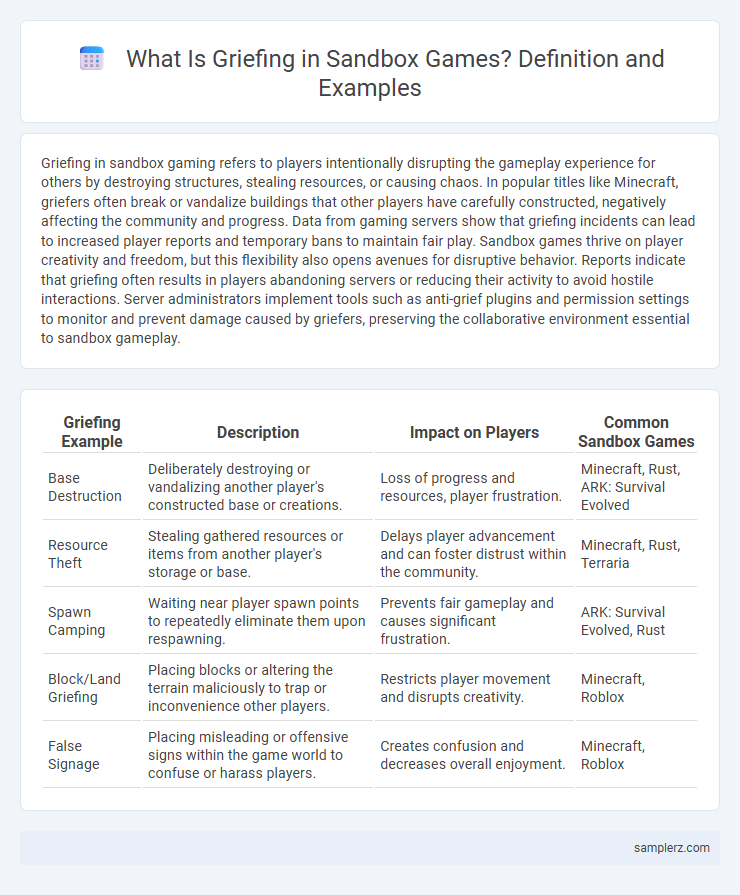Griefing in sandbox gaming refers to players intentionally disrupting the gameplay experience for others by destroying structures, stealing resources, or causing chaos. In popular titles like Minecraft, griefers often break or vandalize buildings that other players have carefully constructed, negatively affecting the community and progress. Data from gaming servers show that griefing incidents can lead to increased player reports and temporary bans to maintain fair play. Sandbox games thrive on player creativity and freedom, but this flexibility also opens avenues for disruptive behavior. Reports indicate that griefing often results in players abandoning servers or reducing their activity to avoid hostile interactions. Server administrators implement tools such as anti-grief plugins and permission settings to monitor and prevent damage caused by griefers, preserving the collaborative environment essential to sandbox gameplay.
Table of Comparison
| Griefing Example | Description | Impact on Players | Common Sandbox Games |
|---|---|---|---|
| Base Destruction | Deliberately destroying or vandalizing another player's constructed base or creations. | Loss of progress and resources, player frustration. | Minecraft, Rust, ARK: Survival Evolved |
| Resource Theft | Stealing gathered resources or items from another player's storage or base. | Delays player advancement and can foster distrust within the community. | Minecraft, Rust, Terraria |
| Spawn Camping | Waiting near player spawn points to repeatedly eliminate them upon respawning. | Prevents fair gameplay and causes significant frustration. | ARK: Survival Evolved, Rust |
| Block/Land Griefing | Placing blocks or altering the terrain maliciously to trap or inconvenience other players. | Restricts player movement and disrupts creativity. | Minecraft, Roblox |
| False Signage | Placing misleading or offensive signs within the game world to confuse or harass players. | Creates confusion and decreases overall enjoyment. | Minecraft, Roblox |
Common Griefing Tactics in Sandbox Games
Common griefing tactics in sandbox games include destroying player-built structures, stealing valuable resources, and trapping characters in inaccessible areas. Players often exploit game mechanics to cause frustration, such as intentionally blocking progress or using glitches to disrupt others' gameplay. These actions undermine collaboration and creativity, making the sandbox environment hostile for cooperative play.
Notorious Griefing Stories from Minecraft
In Minecraft, one of the most notorious griefing stories involves the "X-Team" who destroyed entire player-built villages and landscapes on large multiplayer servers, leaving thousands of players frustrated. Another infamous incident occurred on the Hypixel server, where griefers exploited game mechanics to steal rare resources and sabotage community projects, stirring widespread outrage. These acts of griefing highlight the challenges of maintaining security and player trust in sprawling sandbox environments.
How Griefers Exploit Sandbox Game Mechanics
Griefers exploit sandbox game mechanics by manipulating environmental tools and objects to disrupt other players' progress, such as destroying or removing essential resources and constructions. They often abuse game physics to create inescapable traps or collapse structures, causing frustration and loss without direct player conflict. This exploitation of freedom within sandbox environments undermines collaborative gameplay and challenges developers to balance open interaction with protective measures.
Impact of Griefing on Player Communities
Griefing in sandbox games, such as players intentionally destroying others' builds or stealing resources, severely disrupts the creative freedom and collaboration that define these communities. This toxic behavior leads to decreased player engagement, increased conflicts, and a decline in overall community trust. Game developers often receive negative feedback and see reduced player retention as a direct consequence of widespread griefing.
Famous Griefing Incidents in Roblox
Famous griefing incidents in Roblox include the 2017 "Jailbreak" server chaos where players destroyed key structures and disrupted gameplay for thousands. Another example is the "Adopt Me!" event where griefers used exaggerated spawning exploits to crash servers and ruin the experience for others. These notorious attacks highlight the challenges developers face in maintaining fair play in sandbox environments.
Griefing Through Environment Destruction
Griefing through environment destruction in sandbox games involves players deliberately damaging or dismantling structures built by others, such as demolishing houses or defacing landscapes in games like Minecraft or Terraria. This behavior disrupts the creative process and can lead to significant loss of time and resources for the affected players. Developers often implement protection tools like claim blocks or rollback features to mitigate the impact of such griefing tactics.
Social Engineering as a Griefing Method
Griefing in sandbox games often involves social engineering tactics where players manipulate or deceive others to gain control or cause disruption. Examples include impersonating trusted players to trick others into giving away valuable items or accessing private builds in games like Minecraft or Roblox. This method exploits trust and social dynamics rather than relying solely on game mechanics for sabotage.
Griefing and Base Raids in Open-World Titles
Griefing in sandbox games often involves players intentionally disrupting others' progress by destroying structures or stealing resources during base raids, common in open-world titles like Rust and Ark: Survival Evolved. These actions create high-stakes environments that challenge players' strategic planning and community cooperation. Developers mitigate griefing through mechanics like base fortifications, raid cooldowns, and restricted time zones to enhance fair play and preserve gameplay balance.
Creative Builds Ruined by Online Griefers
Online griefers often ruin creative builds in sandbox games by deliberately destroying intricate structures and artworks crafted by players. These malicious actions include toppling elaborate castles, erasing detailed pixel art, and dismantling complex machinery, which discourages creativity and collaboration. The persistent threat of griefing forces many players to invest time in protective measures rather than imaginative building.
Strategies for Preventing Griefing in Sandbox Games
Implementing robust anti-griefing systems such as player reporting tools, area protection mechanics, and permission-based building controls significantly reduces destructive behavior in sandbox games. Frequent server monitoring combined with automated detection algorithms helps identify and sanction repeat offenders swiftly. Encouraging community moderation and promoting positive player interactions foster a safer environment that deters griefing effectively.

example of griefing in sandbox Infographic
 samplerz.com
samplerz.com